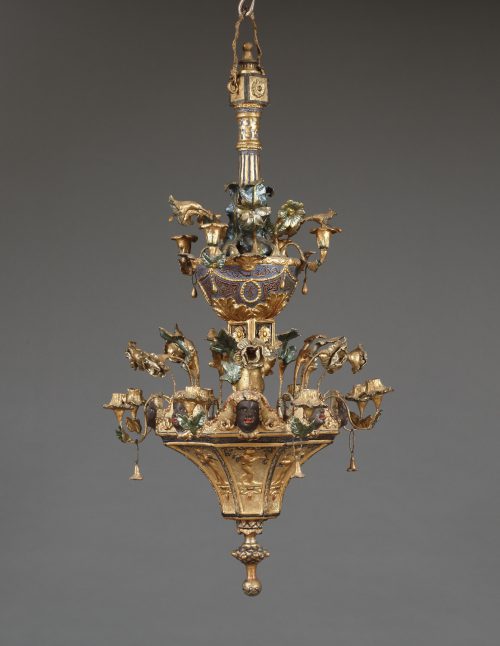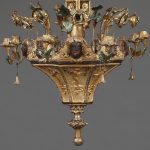11352 AN UNUSUAL GILT PASTIGLIA AND POLYCHROME TWELVE-LIGHT CHANDELIER Possibly Sicily. Early 19th Century. Measurements: Height: 49 1/4″ (125 cm) Diameter: 24 7/8″ (63 cm)

Research
Of gilded and polychrome wood and pastiglia. The flared lower part set with panels of winged putti. Above is a series of arched sections, each set with a nubian mask with exotic headdress, scrolling candle arms issue from in between each of the sections. The baluster stem with vasiform section decorated with acanthus leaves and looping swags is topped by four scrolling arms candle holders and naturalistic flowers. The circular tapering stem terminating in a regular block set with paterae with inverted finial above. Some redundant original drill holes, apparently never used to contain flower stems. Minor restorations in line with age and use. Formerly electrified.
This most unusual chandelier is modeled in the Italian medium known as pastiglia. Various recipes for the material were used in Italy from the 14th century onward, but typical ingredients in the aggregate mixture included lime, sand, whiting, egg white and vinegar, sometimes with animal hair added as a binder.
In Renaissance Italy pastiglia was much prized for the decoration of caskets, where it was often left undecorated in its natural white color to resemble ivory. An exquisite casket made in this technique for Cardinal Bernardo Cles, and bearing his arms, can be dated to the 1530’s, and is today in the Victoria & Albert Museum.
The present chandelier is decorated with an eclectic sculptural mixture of motifs, including beturbaned Nubian masks, winged putti, classical vases and naturalistic flowers. It appears to be unique as it does not rely on any previous known lighting prototypes, and was probably conceived for an integrated interior scheme of a highly fantastical nature, possibly a garden pavilion.
The coloration is also a remarkable feature of the piece, as the flowerheads are applied with an opaque tinted glaze over a white ground, which provides a shimmering quality when the candles are lit. This type of colored glaze may give a clue to the region the chandelier was made, as early nineteenth century pieces made in Sicily employed this unusual technique, such as a three-piece suite “à la Turque” sold by Semenzato Casa D’Aste, Venice, 24 September 2000, Lot 379.


Comments are closed.